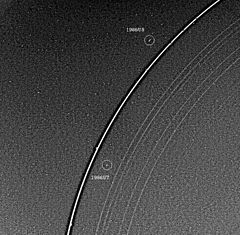Ophelia (moon)
moon of Uranus
Ophelia is a closer moon of Uranus. It was found from the images taken by Voyager 2 on January 20, 1986, and was given the designation S/1986 U 8. It was not seen until the Hubble Space Telescope saw it in 2003.
| Discovery | |
|---|---|
| Discovered by | Richard J. Terrile / Voyager 2 |
| Discovery date | January 20, 1986 |
| Orbital characteristics | |
Mean orbit radius | 53,763.390 ± 0.847 km |
| Eccentricity | 0.00992 ± 0.000107 |
| 0.37640039 ± 0.00000357 d | |
| Inclination | 0.10362 ± 0.055° (to Uranus' equator) |
| Satellite of | Uranus |
| Physical characteristics | |
| Dimensions | 54 × 38 × 38 km |
Mean radius | 23 ± 4 km |
| ~6600 km² | |
| Volume | ~41,000 km³ |
| Mass | ~5.1×1016 kg |
Mean density | ~1.3 g/cm³ assumed |
| ~0.0070 m/s2 | |
| ~0.018 km/s | |
| synchronous | |
| zero | |
| Albedo | 0.08 ± 0.01 |
| Temperature | ~64 K |

Ophelia was named after the daughter of Polonius, Ophelia, in William Shakespeare's play Hamlet. It is also designated Uranus VII.
Unfortunately, other than its orbit, radius of 23 km and geometric albedo of 0.08, almost nothing is known about it. At the Voyager 2 images Ophelia appears as a streched object, the major axis pointing towards Uranus.
Other websites
change- Ophelia Profile Archived 2007-08-01 at the Wayback Machine by NASA's Solar System Exploration